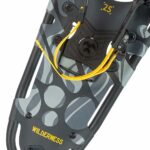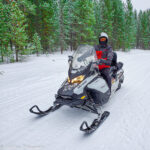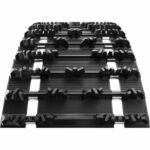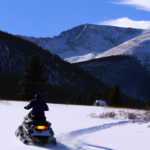Exploring the frigid wilderness on a snowmobile can be an invigorating experience, but have you ever stopped to consider the design elements that make it possible? One critical part of your snowmobile that you may not have thought about is the width of the track. Knowing the width of your snowmobile track may be more important than you think. It contributes to the overall stability, maneuverability, and performance of your vehicle. in this article, “How Wide Is A Snowmobile Track?” you’ll get to understand the typical dimension of a snowmobile track, why it matters, and how it affects your snowmobiling trip. Get ready for a blast of knowledge as chillingly cool as the winter snow.
Understanding Snowmobile Tracks
When it comes to snowmobiling, your machine’s performance is crucial. It all starts with your snowmobile track, the part that keeps you connected to the broad blankets of snow ahead of you.
The role of the snowmobile track
A snowmobile track is primarily responsible for propelling your vehicle forward. It grips the snow and shifts it backward, allowing the snowmobile to advance. Apart from mobility, the track also lends to the stability of the snowmobile, especially when the machine turns or moves downhill.
Importance of track width
The width of the snowmobile track plays a significant role in how the snowmobile performs. A wider track offers better flotation, which is crucial in deeper snow conditions, while a narrower track provides precise steering and maneuverability, beneficial in groomed trail riding.
Different types of snowmobile tracks
There are various types of snowmobile tracks available, each designed to serve different riding conditions. Mountain tracks, for instance, are wider and longer to provide more flotation in deep snow. Trail tracks, on the other hand, are shorter and narrower for better agility and speed on groomed trails.
Typical Width of a Snowmobile Track
Understanding the average width of a snowmobile track can help you better grasp how your machine will perform.
General dimensions
The typical width of a snowmobile track is between 15 to 20 inches, with lengths varying from around 121 to 174 inches. Keep in mind that these measurements can vary significantly between different snowmobile models and manufacturers.
Width variance between models
The width of a snowmobile track can vary greatly from one model to another. This variance is primarily due to differences in design, intended use, and manufacturer’s choices.
Impact of track width on performance
Track width directly impacts your snowmobile’s performance. A wider track might slow your snowmobile’s speed but provides better flotation for riding in deeper snow. Conversely, a narrower track can make your snowmobile faster on groomed trails but offers less flotation in powder snow.
Factors Influencing Snowmobile Track Width
Numerous factors affect the width of the snowmobile track.
Manufacturer design choices
Manufacturers design snowmobile tracks based on intended use, performance expectations, and aesthetics. These could mean the difference between a narrow, agility-driven track or a wider, stability-required track.
Intended use of the snowmobile
If snowmobiling in deep powder snow is your preference, then a wider track would suit you better. Those who enjoy racing over groomed trails with speed would be better off with a narrower track.
The role of track length
While less focused on than the width, track length also plays a critical role in snowmobile performance. Longer tracks can increase overall flotation and provide added traction, but can also make the snowmobile more challenging to handle.
Impact of Track Width on Snowmobile Performance
Track width heavily influences how your snowmobile handles and performs.
Turning ability
Narrower tracks make for easier, sharper turns as there’s less friction against the snow. Conversely, wider tracks might affect your snowmobile’s turning ability due to the increased surface area in contact with the snow.
Impact on speed
Wider track widths might decrease your snowmobile’s speed as the increased surface area generates more friction against the snow. A narrower track can yield higher speeds.
Effects on traction and stability
Wider tracks give you better traction, especially in deep snow conditions – they simply have more surface area gripping the snow. Furthermore, stability increases with wider tracks due to a larger contact patch, reducing the risk of tipping over during turns.
Choosing the Right Track Width for Your Needs
Selecting the right track width is crucial to tailor your snowmobile’s performance.
Consider your typical riding conditions
The type of conditions you typically ride in will dictate which track width is optimal. Powder snow conditions necessitate wider tracks, while groomed trails can be tackled with narrower tracks.
The influence of personal preferences
Your style of riding also plays a role in choosing track width. If you’d prefer maneuverability and speed, you’d gravitate towards narrower tracks. For stability in rough conditions and superb flotation, wider tracks are ideal.
Understanding the manufacturer’s recommendations
Manufacturers provide track width recommendations based on the intended use of the snowmobile. These suggestions should guide your track width decision.
Snowmobile Track Maintenance and Care
Taking care of your snowmobile track will prolong its life and maintain your snowmobile’s performance.
Routine inspection
Regular checks for any signs of damage, such as cuts or tears, can save you from a lot of trouble down the line. Early detection allows timely repairs or track replacement.
Cleaning the snowmobile track
After every ride, remove any debris or snow caught in your snowmobile track. This not only reduces strain on your snowmobile but also minimizes damage to the track’s rubber material.
Proper storage practices
Store your snowmobile in a clean, dry place to prevent the track from deteriorating. Moreover, some snowmobilers recommend loosening the track tension when storing for extended periods to prevent it from stretching.
How to Measure Snowmobile Track Width
If you’re unsure about your track width, here’s how you can measure it.
Tools required
To measure your track width, all you need is a simple measuring tape.
Measurement procedure
Extend the measuring tape across the full width of the snowmobile track from one outer edge to the other. Take measurements at multiple points to ensure accuracy.
Interpreting measurement result
The measurement you receive should fall within the typical range of snowmobile track widths, i.e., 15 to 20 inches.
Common Problems with Incorrect Track Width
Having an incorrect track width can negatively impact your snowmobile experience.
Effects on handling
An unsuitable track width can heavily affect your snowmobile’s handling ability. It may cause your snowmobile to be unstable or significantly reduce its maneuverability.
Wear and tear on snowmobile components
Improper track width can cause uneven and premature wear on different components of your snowmobile, including the drivetrain, suspension, and even your track itself.
Safety concerns
Wrong track width, particularly if too narrow, can lead to instability and cause accidents, compromising your safety on the trails.
Upgrading or Replacing Your Snowmobile Track
If your track has run its course, it might be time for a replacement or an upgrade.
Signs that replacement is needed
Signs like excessive wear, visible cuts or tears, or changing riding conditions can indicate it’s time to replace your snowmobile track.
Choosing the correct replacement track
When selecting a replacement track, consider your typical riding conditions, personal preferences, and manufacturer’s recommendations in terms of width.
Understanding the installation process
Installing a new snowmobile track isn’t a DIY process for everyone. Unless you’re mechanically inclined and have the necessary tools, it might be best to have a professional handle the installation.
Role of Track Width in Snowmobile Racing
Track width plays a vital role in competitive snowmobile racing.
Track width regulations in racing
Most racing associations have regulations concerning the width of the snowmobile track. Always make sure to check these rules before making any alterations.
Performance benefits of different track widths
Each track width has its pros and cons when it comes to racing. Narrower tracks offer speed and agility – favorable for racing. However, stability and traction provided by wider tracks may also be beneficial on certain terrains.
Choosing a racing track
Choosing a racing track is a lot like choosing a trail track. Your preference for speed or stability, the nature of the racing terrain, and regulations should guide your decision.
When properly chosen and cared for, your snowmobile track can significantly enhance your snowmobiling experience, offering the ride of your life. From navigating trails to competitive racing or simply gliding over the pure white powder, the right track width makes all the difference.
- What Snowboard Bindings Should I Get? - January 23, 2024
- What Size Screws For Snowboard Bindings? - January 23, 2024
- How To Snowmobile On Water? - January 23, 2024










